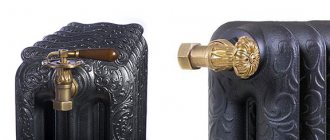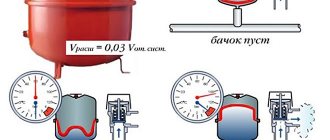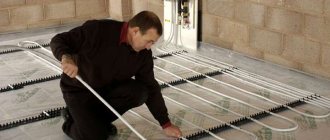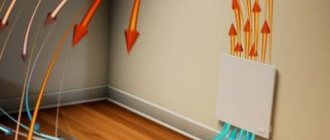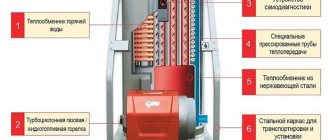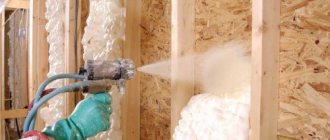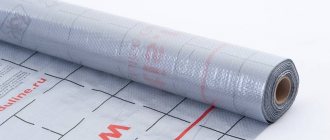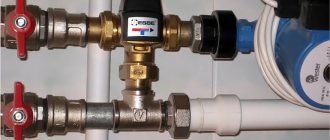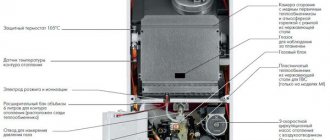To tightly shut off the flow of water, in addition to shut-off valves, shut-off and control valves can be used. It is an inseparable part of heating and water supply systems.
Shut-off and control valves
Shut-off and control pipeline valves combine the basic characteristics of control and shut-off valves and are used to control flow, compliance with specified parameters, and correct mixing of liquids and gases.
Main types of shut-off and control valves
Shut-off and control valves are used for heating and water supply systems, steam systems, as well as in industry for petrochemical, chemical and pharmaceutical enterprises, where they perform the task of regulating the flow of liquid, steam or gas. The following types of devices are distinguished:
- Saddle.
- Ball.
- Wedges.
- Slide-knife.
- Rotary disc.
Shut-off valve device
Shut-off and control valves
In addition to locking functions that prevent emergency situations on the circuit, the fittings can be used to regulate the flow of coolant. There is a separate range of shut-off and control valves, when used in the circuit, you can smoothly regulate the temperature of the coolant, stabilize the pressure in the circuit, and also control the direction of water circulation in the system.
Shut-off and control valves are represented by the following elements:
- balancing valve;
- check valve;
- make-up valve;
- thermal valve;
- relief valve;
- heating system bypass valve.
Balancing valve
Installers use a heating system balancing valve to balance multiple hydraulic circuits. This mechanism allows you to increase the efficiency of the heating system, as it helps to clearly control the permissible coolant flow. A properly connected balancing valve for a heating system, the operating principle of which is to distribute the coolant evenly throughout all areas of the system using a special valve, can fully function in difficult conditions. In particular, the valve can withstand strong pressure surges in the circuit and high rates of coolant circulation through the pipes.
By design, a balancing valve for a heating system, the price of which is about $150 for a direct-acting model, consists of several key elements:
- body made of steel, brass or silumin;
- membrane septum;
- position lock;
- shutter indicator;
- pipe branch;
- measuring diaphragm.
Check valve
This type of control valve prevents water hammer and increases the reliability of the system. As can be understood from the name of the fittings, the valve does not allow reverse flow of coolant in the system. For optimal combination with the circuit, it is necessary to select a valve with the appropriate internal diameter. The design of the device is quite simple - the main element of the valve is a spring, which holds the rod and closes it in the event of an accident on the circuit. You can read more about the check valve in our article “Why is a check valve needed for heating”.
Make-up valve
In order for coolant circulation to be effective, the optimal amount of water or antifreeze must be present in the circuit. Therefore, a make-up valve for a heating system is a mandatory element of any circuit. This type of fittings allows you to compensate for possible coolant losses caused by the use of Mayevsky taps, drain valves or the presence of leaks in heating devices.
The function performed by the heating system make-up valve is to control the amount of coolant in the circuit and, if necessary, replenish it.
It is best to use an automatic refill valve for the heating system in the circuit, which is equipped with a reducing mechanism and a special membrane under coolant pressure.
When the pressure in the circuit decreases, the coolant does not exert pressure on the membrane, the rod, pushed by the spring, falls and opens a gap in the seat. As a result, the circuit is fed from the water supply until the pressure in the system normalizes.
Thermal valve
The thermal control valve for a heating radiator is one of the most effective types of fittings. The valve allows you to increase the functionality of the circuit and make the heating process simple, comfortable and rational. It can be automatic or mechanical. A mechanical thermal valve for heating consists of two main parts. This is a thermal head and valve. The automatic analogue has a more complex design.
An automatic thermal valve is characterized by the presence of the following elements:
- temperature sensor in built-in or remote format;
- programmer;
- automatic control system.
An automatic thermal valve regulates the temperature in the circuit according to the settings previously specified by the user. This device has a fairly high cost and allows you to optimize the operation of the system as much as possible.
Relief valve
If the pressure in the system exceeds the norm, then the risk of accidents, damage to the circuit and even a boiler explosion is inevitable. In view of this, installers use a pressure relief valve in the heating system, which will prevent pressure surges in the event of an accident or overheating of the coolant. When choosing a place to install fittings of this type, it should be taken into account that the greatest likelihood of an increase in coolant pressure occurs in the boiler as a result of overheating of the coolant.
Even modern boiler models that have a gas valve installed for the boiler are not one hundred percent insured against emergency situations.
It is recommended to install a heating relief valve as close as possible to the boiler, on the supply pipe.
When choosing a model, you should pay attention to valves equipped with additional options in the form of pressure gauges and air vents. Such valves are more reliable and practical.
Bypass valve
This type of fittings is used to normalize the pressure difference between supply and return. It is imperative to use a heating system bypass valve in circuits with connected thermal valves. These devices contribute to the creation of pressure drops on certain branches of the circuit and lead to a decrease in the efficiency of the heating system. Bypass valves normalize the difference in pressure and return the circuit to performance and efficiency.
Shut-off valves for heating systems are represented by a wide range of devices for various purposes. However, the choice of a specific type of fittings must be made in accordance with the heating project developed for a particular building. Such measures are due to the fact that each house has different types of pipelines and heating devices, based on the specifications of which, an individual selection of fittings must be made.
General characteristics of globe valves
Saddle fittings can be used for heating and water supply systems both for the purpose of regulation and limitation, and as a shut-off valve. The main types of saddle fittings include the following components:
- Packed shut-off valves;
- Angular;
- Bellows;
- Regulatory;
- High pressure valves;
- Boiler blowdowns.
The design of the saddle valve body is made in various versions depending on the type of connection, which is necessary for engineering systems. Valves are available with the following connection options:
- Coupling;
- Flanged;
- Threaded;
- Welding.
Bellows fittings
There are different types of saddle fittings depending on the material of manufacture. The main varieties include a body of:
- Gray and ductile iron;
- Cast steel;
- Of stainless steel;
- Bronze.
A wide range of operating temperatures (-60 - +450 ˚С) allows the use of seat valves for heating and hot water supply systems.
Durable and chemically resistant materials that are used to manufacture the shut-off valve allow the use of such components in both neutral and aggressive liquids and gases. This is the most profitable option for shut-off and control valves in terms of cost and technical capabilities.
Characteristics and features of the use of ball valves
In ball devices, the movable part of the shutter plays the role of a regulatory element. Such devices are used for plumbing systems and include the following types:
- High pressure ball valves;
- Three-way regulating;
- Industrial;
- Ball valves equipped with metal seats.
Ball Valves
The main advantages of ball valves, which distinguish them favorably from other types of shut-off and control valves:
- Minimum hydraulic resistance;
- Device reliability;
- Ease of operation;
- Performance;
- Suitable for fire and explosive, toxic and aggressive environments.
Ball valves can have various designs of end elements and connections, namely:
- Threaded;
- Flanged;
- Welded.
Ball valve device
Ball valves can be equipped with electric or pneumatic actuators to automate the process of adjusting the water flow. The convenience of ball valves is their long service life and minimal maintenance.
Wedge valves as flow regulators
Wedge valves are characterized by perpendicular movement of the control element in relation to the flow of liquid or gas. Wedge valves can be used for water supply, heating, gas supply systems, as well as oil pipelines, technological and transport pipelines. Key features of the device include:
- Possibility of operation in any conditions;
- Simplicity of design;
- Reliability;
- Wear resistance;
- Low hydraulic resistance;
- Service life is up to 30 years.
Wedge valves
The disadvantages of wedge valves for heating include:
- Long valve closing time;
- Difficulty in carrying out repair work.
Although there are options for gate valves, these are still rare. Most often, wedge valves are used as exclusively shut-off valves, which operate in two positions - open and closed.
Valves
This fitting product performs exclusively a locking function. Due to the design features, the valves can only be in two positions, since the mechanism has a locking element located perpendicular to the coolant flow. If the valve element is in an open position, the heated liquid enters the circuit, and when it is closed, it does not allow it to circulate.
The valve has a number of features:
- Provides low hydraulic resistance in the circuit.
- It has an optimal internal diameter size that matches the cross-section of the pipeline.
- It's easy to install.
- It is highly reliable.
Read with this
- How to choose and install an air valve for heating
- Connection diagrams for bimetallic radiators
- What to do if the bottom of the battery is cold and the top is hot?
- Review of taps for the heating system, description of their functional and operational features
- Benefits of using a duct extension for radiators
- Sewage check valve
- Leningrad heating system for a private house
- Safety relief valve: operating principle, applications and installation
- Heating battery does not warm up
- Installing a heating bypass: 15 photos with the process and examples of work
Knife gate shut-off and control valves
Gate valves are equipped with a flat-shaped locking element - a gate. Depending on the type of construction, there are:
- Single disc valves;
- Double disc.
This type of shut-off and control valves is used for work in difficult working environments - for wastewater processing, water purification, processing of mineral raw materials, chemical products. The main advantages of gate valves:
- Minimum maintenance requirements;
- Full bore;
- Easily replaceable ring elements;
- Complete isolation of the gate knife from the solution flow in the open position.
Knife gate valves
Shut-off valves
In heating systems, shut-off valves for heating are used to control the supply of coolant, as well as to open the circuit. It allows you to control the heating process, making it more efficient and rational. In most cases, the shut-off valve on the heating radiator is installed in the radiator piping areas. In addition to functional advantages, this solution also has practical benefits - by closing the shut-off valve for the heating radiator, the homeowner will be able to repair the heating device without stopping the operation of the entire heating system. At the moment, shut-off valves for heating are represented by a wide range of devices.
The following types of devices are often used in heating systems:
- shut-off valves;
- Ball Valves;
- needle valve;
- valves
These elements are made of durable metals that are resistant to corrosion and high temperatures. Shut-off valves protect the circuit from critical emergencies and increase the reliability of the heating system, helping to minimize the negative consequences of failure of an individual heating device.
Ball Valves
A ball valve is a shut-off valve for heating radiators, which is installed to regulate the flow of coolant. The design of the fittings includes a union nut, an internal thread, a plug and an air release device designed to bleed air from the system.
When choosing this type of fittings, you need to pay attention to the material from which the valve is made and the presence of o-rings, which increase the service life of the element in the circuit. Brass taps have proven themselves well, as they are characterized by increased wear resistance and corrosion resistance.
Shut-off valves
This type of fittings is used to make it possible to replace radiators without draining the coolant from the circuit. Based on their design features, there are angle and straight shut-off valves. Moreover, some models can be equipped with a release mechanism to smoothly reduce the pressure in the circuit. Shut-off valves are characterized by a hose nozzle - it allows installation of the device as quickly and simply as possible.
Needle tap
The functions performed by a needle tap for heating can be different. Depending on the design, this device can perform locking, regulating and balancing functions. In heating systems, a shut-off needle valve for the heating radiator is most often used, which allows you to smoothly shut off the flow and avoid the occurrence of water hammer, which is detrimental to the system. Unlike a ball valve, which has two operating positions, a needle valve can operate in three positions:
- "closed";
- "open";
- "partially closed".
Valves
This type of valve performs exclusively a shut-off function. Due to its design features, it can operate in two modes - the mechanism is equipped with a locking element located perpendicular to the coolant flow. In the open position, the valve supplies coolant to the circuit, and in the closed position it prevents its circulation. Among the features of the valve, it is worth noting the low hydraulic resistance created in the circuit, the optimal diameter of the internal section, which coincides with the diameter of the pipeline, simple installation and high reliability.
Characteristics of butterfly valve
A rotary disk is used as a locking and regulating element. Dampers are widely used in heating, water supply and air conditioning systems. The operating medium of the damper can be process or treated water. The main elements of this device are:
- Frame;
- Disk;
- Upper shaft;
- Lower shaft;
- Saddle;
- Bearings;
- Lid;
- O-ring;
- Thrust ring;
- Pinch bolt;
- Key;
- Liner;
- Nuts and washers.
Butterfly valve
The main advantages of this device are:
- Low cost;
- Easy to operate and maintain.
Disadvantages of the butterfly valve:
- Sensitivity to pressure changes;
- Limited ability to regulate the flow of working fluid.
Fittings for heating radiators
There is a wide range of similar elements on the market. The following are installed on heating radiators:
- radiator taps;
- thermal heads;
- Mayevsky cranes.
Radiator tap is a fitting for a smooth and uniform supply of coolant to the radiator of the heating system. It protects against sudden changes in pressure. There are corner and straight radiator taps. They are selected taking into account the design features of the installation.
Simple radiator valve
Due to the smooth adjustment, you can set the required level of coolant supply, taking into account the required temperature conditions in the room. Double insulation provides protection and makes the adjustment process more precise.
Thermal head
Comprises:
- housings;
- bellows;
- rod;
- pusher;
- return spring.
Adjusting head for radiator
The principle of operation is the effect of room air on a bellows located in a closed space. The filler expands, the bellows becomes larger and, through a rod with a pusher, it acts on the thermostatic valve pin. Inside the latter, the rod with the spool moves down, reducing the throughput. This is how the coolant supply is limited.
Mayevsky crane
This radiator fitting is designed to bleed air from the radiator. In other words, it helps reduce pressure in the heating system. Available in several variations. There are also automatic ones. Applicable in:
- apartment buildings;
- high-rise buildings;
- administrative buildings;
- systems of residential areas;
- production premises;
- office buildings.
It consists of a metal case with a small hole and a plastic inner ring. Inside it there is a thread and a clamping bolt. There is a hole in the holder to release the coolant. The clip can rotate 360 degrees.
Technological process of operation of shut-off and control valves
| Author | Share | Rate |
| Victor Samolin |
Interesting on the topic:
Features and areas of application of shut-off valves
Shut-off and drainage valves for water supply systems
How to install copper pipes yourself
Comments on this article
Sefandnaf Good afternoon
What brand of ball valves can you recommend? Everyone gives different advice, it’s hard to decide. 01/31/2016 at 02:11
